小学英语四年级下第一单元第一课
- 格式:doc
- 大小:36.50 KB
- 文档页数:4
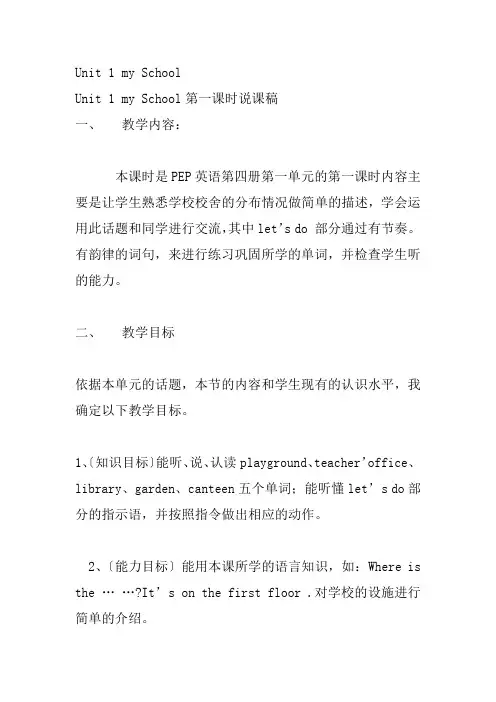
Unit 1 my SchoolUnit 1 my School第一课时说课稿一、教学内容:本课时是PEP英语第四册第一单元的第一课时内容主要是让学生熟悉学校校舍的分布情况做简单的描述,学会运用此话题和同学进行交流,其中let’s do 部分通过有节奏。
有韵律的词句,来进行练习巩固所学的单词,并检查学生听的能力。
二、教学目标依据本单元的话题,本节的内容和学生现有的认识水平,我确定以下教学目标。
1、〔知识目标〕能听、说、认读playground、teacher’office、library、garden、canteen五个单词;能听懂let’s do部分的指示语,并按照指令做出相应的动作。
2、〔能力目标〕能用本课所学的语言知识,如:Where is the ……?It’s on the first floor .对学校的设施进行简单的介绍。
3、〔情感目标〕培养学生的动手能力和创作才能,爱护自己学校的情感。
三、教学准备多媒体课件和图片四、四、教学重、难点重点是听、说、认读本节课时的主要单词:playground、teacher’ office、library、garden、canteen;难点是新单词library中辅音连缀的发音。
五、教学过程﹝一﹞激趣导入:Welcome back to school.I am very glad to meet you.1、A Song: our school.2、A game: 逐步出现图片的一小部分,请学生猜。
〔设计思路〕在歌声中开始新课,使课堂气氛愉快、活跃、、。
在游戏中复习旧单词flower、book、noodles、teacher’s desk、football、又不失时机地加入water the flower /reed a story book/ eat some noodles/play football/hand in the homework 的教学。
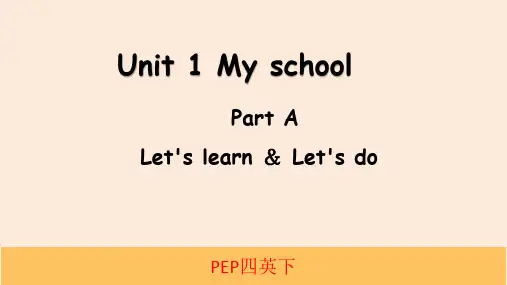
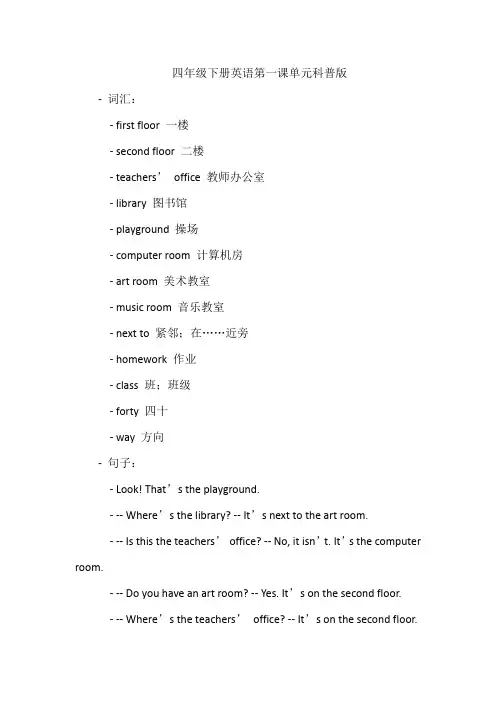
四年级下册英语第一课单元科普版-词汇:- first floor 一楼- second floor 二楼- teachers’office 教师办公室- library 图书馆- playground 操场- computer room 计算机房- art room 美术教室- music room 音乐教室- next to 紧邻;在……近旁- homework 作业- class 班;班级- forty 四十- way 方向-句子:- Look! That’s the playground.--- Where’s the library? -- It’s next to the art room.--- Is this the teachers’office? -- No, it isn’t. It’s the computer room.--- Do you have an art room? -- Yes. It’s on the second floor.--- Where’s the teachers’office? -- It’s on the second floor.- Excuse me.- The teachers’office is next to the library.- Here’s my homework.- Welcome to our school! This is my classroom.---How many students are there in your class? --Forty-five students.--- Do you have a library? -- Yes, we do.- This is my school!-句型结构:--- Where’s + 事物(the teachers’office, the classroom…)? -- It’s + 表示地点的介词短语(on the first floor, next to the library…).- It’s on the + 序数词(first, second…)+ floor.--- Is this/ that + 事物(the library, the computer room…)? -- Yes, it is. No, it isn’t.--- Do you have + 某事物(a toy bear, a music room…)? -- Yes, I/ we do. No, I/ we don’t.-This is + a/ an/ the/ 形容词性物主代词/ 名词性物主代词+ 事物名称。
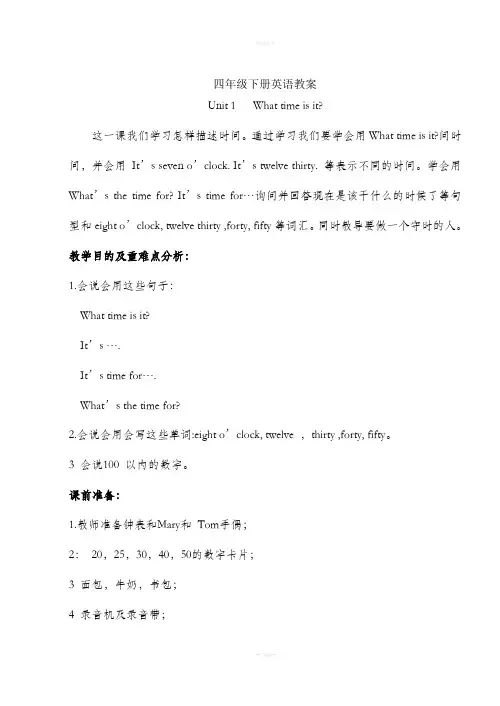
四年级下册英语教案Unit 1 What time is it?这一课我们学习怎样描述时间。
通过学习我们要学会用What time is it?问时间,并会用It’s seven o’clock. It’s twelve thirty. 等表示不同的时间。
学会用What’s the time for? It’s time for…询问并回答现在是该干什么的时候了等句型和eight o’clock, twelve thirty ,forty, fifty等词汇。
同时教导要做一个守时的人。
教学目的及重难点分析:1.会说会用这些句子:What time is it?It’s ….It’s time for….What’s the time for?2.会说会用会写这些单词:eight o’clock, twelve ,thirty ,forty, fifty。
3 会说100 以内的数字。
课前准备:1.教师准备钟表和Mary和Tom手偶;2:20,25,30,40,50的数字卡片;3 面包,牛奶,书包;4 录音机及录音带;5 早饭,上学,上课,午饭的单词卡片;6. 学生准备钟表,纸表盘和水彩笔。
教学过程:1.热身(Warming up)老师拿出钟表,利用Mary和Tom手偶进行对话引出本课话题。
A: Hi, what’s this ?B: Oh. It’s a clock.A: What time is it?B: It’s seven fifteenA: What’s the time for?B: It’s time for breakfast.A: Now what time is it?B: It’s eleven forty-five. It’s time for lunch.2. 新课展示(New Presentation)老师通过钟表和数字卡片讲解本课重点句型What time is it? It’s seven o’clock. It’s twelve thirty .What’s the time for? It’s time for…及词汇eight o’clock, twelve,thirty ,forty, fifty。
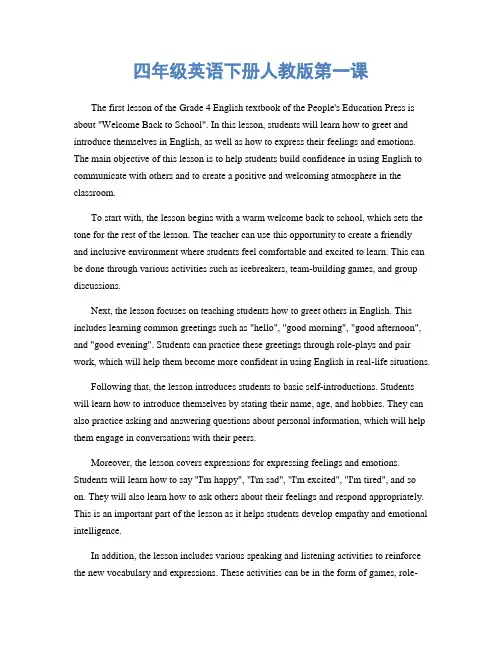
四年级英语下册人教版第一课The first lesson of the Grade 4 English textbook of the People's Education Press is about "Welcome Back to School". In this lesson, students will learn how to greet and introduce themselves in English, as well as how to express their feelings and emotions. The main objective of this lesson is to help students build confidence in using English to communicate with others and to create a positive and welcoming atmosphere in the classroom.To start with, the lesson begins with a warm welcome back to school, which sets the tone for the rest of the lesson. The teacher can use this opportunity to create a friendly and inclusive environment where students feel comfortable and excited to learn. This can be done through various activities such as icebreakers, team-building games, and group discussions.Next, the lesson focuses on teaching students how to greet others in English. This includes learning common greetings such as "hello", "good morning", "good afternoon", and "good evening". Students can practice these greetings through role-plays and pair work, which will help them become more confident in using English in real-life situations.Following that, the lesson introduces students to basic self-introductions. Students will learn how to introduce themselves by stating their name, age, and hobbies. They can also practice asking and answering questions about personal information, which will help them engage in conversations with their peers.Moreover, the lesson covers expressions for expressing feelings and emotions. Students will learn how to say "I'm happy", "I'm sad", "I'm excited", "I'm tired", and so on. They will also learn how to ask others about their feelings and respond appropriately. This is an important part of the lesson as it helps students develop empathy and emotional intelligence.In addition, the lesson includes various speaking and listening activities to reinforce the new vocabulary and expressions. These activities can be in the form of games, role-plays, and pair work, which will provide students with ample opportunities to practice using English in a fun and interactive way.Furthermore, the lesson encourages students to use English in their daily interactions with teachers and classmates. This can be achieved through classroom routines, such as greeting the teacher in English at the beginning of the class, or sharing their feelings and emotions during group discussions.To sum up, the first lesson of the Grade 4 English textbook of the People's Education Press, "Welcome Back to School", focuses on building students' confidence in using English to greet others, introduce themselves, and express their feelings and emotions. By creating a positive and welcoming atmosphere in the classroom and providing ample opportunities for practice, students will be able to develop their English communication skills and feel more comfortable using English in their daily lives. This lesson sets a strong foundation for future language learning and lays the groundwork for a supportive and inclusive learning environment.。
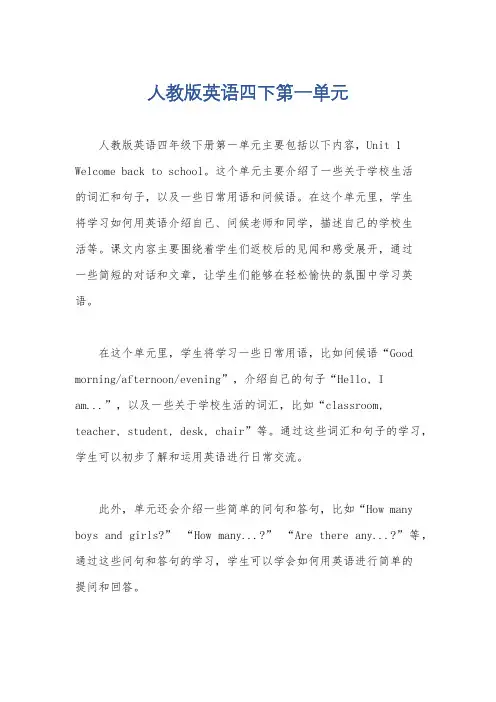
人教版英语四下第一单元
人教版英语四年级下册第一单元主要包括以下内容,Unit 1 Welcome back to school。
这个单元主要介绍了一些关于学校生活
的词汇和句子,以及一些日常用语和问候语。
在这个单元里,学生
将学习如何用英语介绍自己、问候老师和同学,描述自己的学校生
活等。
课文内容主要围绕着学生们返校后的见闻和感受展开,通过
一些简短的对话和文章,让学生们能够在轻松愉快的氛围中学习英语。
在这个单元里,学生将学习一些日常用语,比如问候语“Good morning/afternoon/evening”,介绍自己的句子“Hello, I am...”,以及一些关于学校生活的词汇,比如“classroom, teacher, student, desk, chair”等。
通过这些词汇和句子的学习,学生可以初步了解和运用英语进行日常交流。
此外,单元还会介绍一些简单的问句和答句,比如“How many boys and girls?” “How many...?” “Are there any...?”等,通过这些问句和答句的学习,学生可以学会如何用英语进行简单的
提问和回答。
总的来说,人教版英语四年级下册第一单元主要以学校生活为背景,通过一些简单的词汇和句子的学习,让学生初步感受英语的魅力,培养学生学习英语的兴趣,并为后续学习打下基础。
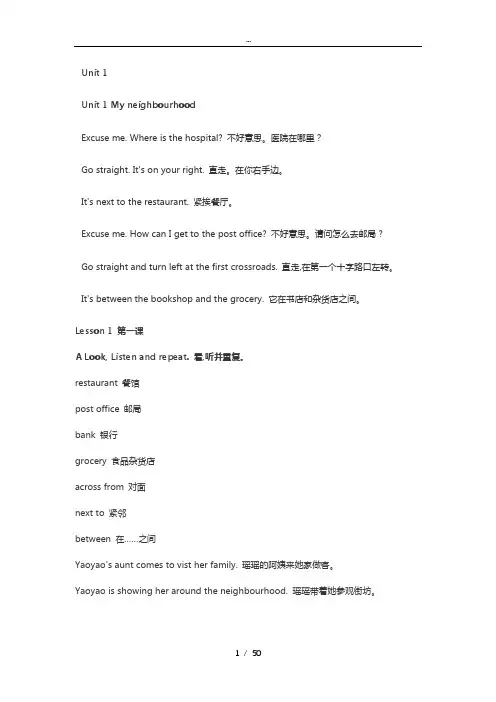
Unit 1Unit 1 My neighbourhoodExcuse me. Where is the hospital? 不好意思。
医院在哪里?Go straight. It's on your right. 直走。
在你右手边。
It's next to the restaurant. 紧挨餐厅。
Excuse me. How can I get to the post office? 不好意思。
请问怎么去邮局?Go straight and turn left at the first crossroads. 直走,在第一个十字路口左转。
It's between the bookshop and the grocery. 它在书店和杂货店之间。
Lesson 1 第一课A Look, Listen and repeat. 看,听并重复。
restaurant 餐馆post office 邮局bank 银行grocery 食品杂货店across from 对面next to 紧邻between 在……之间Yaoyao's aunt comes to vist her family. 瑶瑶的阿姨来她家做客。
Yaoyao is showing her around the neighbourhood. 瑶瑶带着她参观街坊。
"Look, this is a post office. Our school is next to it." "看,这有一间邮局。
我们学校在它旁边。
""Oh, I see. What's that?" "哦,我看到啦。
那是什么?""That's a restaurant. We can eat Beijing duck there. "那是一家餐厅。
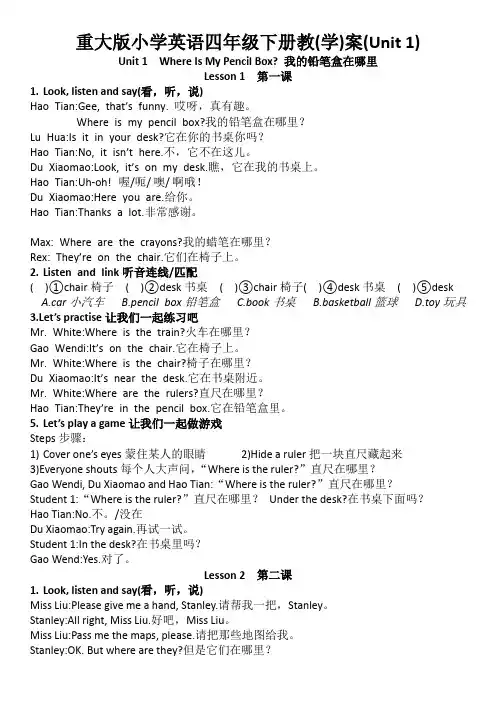
重大版小学英语四年级下册教(学)案(Unit 1)Unit 1 Where Is My Pencil Box? 我的铅笔盒在哪里Lesson 1 第一课1.Look, listen and say(看,听,说)Hao Tian:Gee, that’s funny. 哎呀,真有趣。
Where is my pencil box?我的铅笔盒在哪里?Lu Hua:Is it in your desk?它在你的书桌你吗?Hao Tian:No, it isn’t here.不,它不在这儿。
Du Xiaomao:Look, it’s on my desk.瞧,它在我的书桌上。
Hao Tian:Uh-oh!喔/呃/ 噢/ 啊哦!Du Xiaomao:Here you are.给你。
Hao Tian:Thanks a lot.非常感谢。
Max: Where are the crayons?我的蜡笔在哪里?Rex: They’re on the chair.它们在椅子上。
2.Listen and link听音连线/匹配( )①chair椅子( )②desk书桌( )③chair椅子( )④desk书桌( )⑤deskA.car小汽车B.pencil box铅笔盒C.book书桌 B.basketball篮球D.toy玩具3.Let’s practise让我们一起练习吧Mr. White:Where is the train?火车在哪里?Gao Wendi:It’s on the chair.它在椅子上。
Mr. White:Where is the chair?椅子在哪里?Du Xiaomao:It’s near the desk.它在书桌附近。
Mr. White:Where are the rulers?直尺在哪里?Hao Tian:They’re in the pencil box.它在铅笔盒里。
5.Let’s play a game让我们一起做游戏Steps步骤:1)Cover one’s eyes蒙住某人的眼睛2)Hide a ruler把一块直尺藏起来3)Everyone shouts每个人大声问,“Where is the ruler?”直尺在哪里?Gao Wendi, Du Xiaomao and Hao Tian:“Where is the ruler?”直尺在哪里?Student 1:“Where is the ruler?”直尺在哪里?Under the desk?在书桌下面吗?Hao Tian:No.不。
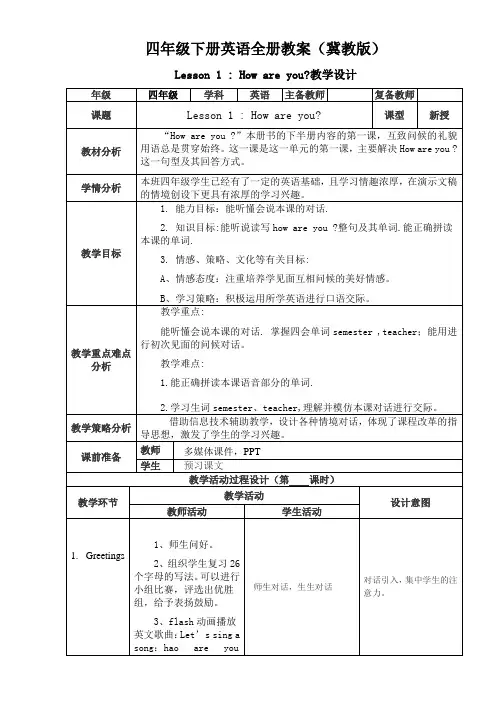
四年级下册英语全册教案(冀教版)Lesson 1 : How are you?教学设计教师领唱后师生随着音乐的节奏同唱,边唱边做动作,渲染课堂的气愤。
板书课题:lesson1how are you?2.New concepts 第一部分: A newsemester教师领读对话、1、第二部分:A new teacher观察图画,让学生说说每幅图画上都看到了什么。
由学生自己根据已经学过的知识试着读句子。
教师领读,学生自由读,小组内读,直到熟练为止。
以相同的方式教学第二至四幅图的句子。
(课件出示对话情境图练习对话)根据老师的提问,积极回答问题,完成对话学生根据图片提问并回答问题。
新授环节主要采用对话形式,集中学生的注意力积极利用多媒体的教学手段,丰富课堂效果Lesson 2:Is this your pencil?教学设计with pictures or real things.(用实物或图片介绍新词)Pair work: What’s in your pencil box?2.Whose pencil is this? Mr.Wood finds a pencil. Whose pencil is it?Let’s listen.(观看第二部分光盘)Is this Jenny’s pencil?Is this Steven’s pencil? Whose pencil is it? Teacher takes a pencil from one of the students, and then asks some students: Whose pencil is this? Is this your pencil? 利用学生手边的实物介绍这些学习用品,更真实自然,同时要有音节教学的渗透。
学生要多看,多听,在动画情境中理解文本的含义。
通过问答,检测学生对文本的理解。
创设情境,鼓励学生运用所学知识进行交际交流。
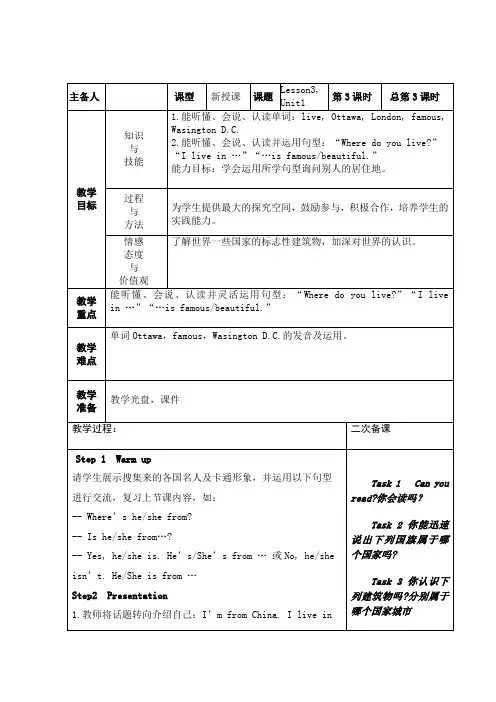
Tai’an. Tai’an is beautiful. 教授单词live 并板书句型“I live in …”,然后引导学生模仿造句。
2.出示Jim的图片,问:What about Jim? Where’s he from. 学生根据第一课学习的内容,会回答:He’s from Canada. 然后教师接着问:Where does he live? 学生不知道,一起看着屏幕问:Jim, Jim, where do you live? 教师引导看文本动画,学生回答,出示词卡学习Ottawa,随后出示该地图片,介绍“It’s beautiful.”3. 教师随后问:What about Mary and Mike? Let’s ask them .屏幕出示人物图片,师生共问:Mary, Mary, where do you live? Mike, Mike, where do you live? 观看文本动画,连线,学习新词London, Washington D.C. 同时出示一些该地风光图片,并介绍:It’s famous.4. Listen and imitate.5.Read the text by themselves.6.Act.Step 3 Practice1.Let’s talk出示第一幅图,请一名学生戴上头饰,另一名学生与其进行问答,教师给予适当帮助,做示范。
-- Where are you from?-- I’m from …-- Where do you live?-- I live in …同桌从四幅图中选择其一进行对话练习,然后全班展示。
2.小组活动,做调查小组内成员每人搜集一位自己了解的中外名人并扮演,组内其他成员运用上述句型进行问答并记录。
3.Let’s copy.Task 4Pairwork (两人一组练习)Task 5Pairwork to make new conversations.两人一组编新对话Task 6Listen and findTask7Groupwork(小组活动,对话过关)Task 8Personal information(个人简(1)教师出示并领读以下三个句子,提示学生注意语音语调准确流畅。
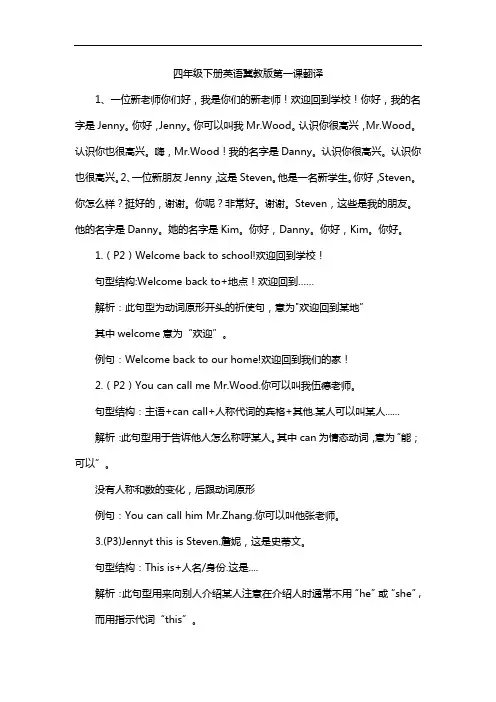
四年级下册英语冀教版第一课翻译1、一位新老师你们好,我是你们的新老师!欢迎回到学校!你好,我的名字是Jenny。
你好,Jenny。
你可以叫我Mr.Wood。
认识你很高兴,Mr.Wood。
认识你也很高兴。
嗨,Mr.Wood!我的名字是Danny。
认识你很高兴。
认识你也很高兴。
2、一位新朋友Jenny,这是Steven。
他是一名新学生。
你好,Steven。
你怎么样?挺好的,谢谢。
你呢?非常好。
谢谢。
Steven,这些是我的朋友。
他的名字是Danny。
她的名字是Kim。
你好,Danny。
你好,Kim。
你好。
1.(P2)Welcome back to school!欢迎回到学校!句型结构:Welcome back to+地点!欢迎回到……解析:此句型为动词原形开头的祈使句,意为"欢迎回到某地”其中welcome意为“欢迎”。
例句:Welcome back to our home!欢迎回到我们的家!2.(P2)You can call me Mr.Wood.你可以叫我伍德老师。
句型结构:主语+can call+人称代词的宾格+其他.某人可以叫某人......解析:此句型用于告诉他人怎么称呼某人。
其中can为情态动词,意为“能;可以”。
没有人称和数的变化,后跟动词原形例句:You can call him Mr.Zhang.你可以叫他张老师。
3.(P3)Jennyt this is Steven.詹妮,这是史蒂文。
句型结构:This is+人名/身份.这是....解析:此句型用来向别人介绍某人注意在介绍人时通常不用“he”或“she”, 而用指示代词“this”。
例句:This is Lily.这是莉莉This is my teacher.这是我的老师4.(P3)How are you?你好吗?句型结构:How are you?你好吗?解析:此句为常用口语,意为“你好吗”,通常用于询问对方的身体状况,是熟人之间打招呼的常用语,回答语一般为"Fine,thank you.'或者“Very well,thanks.等例句:一How are you?你好吗?—Fine,lliank you,很好,谢谢你课外拓展:在英语中一般疑问句在朗读或对话时,要用升调如课文中And you?特殊疑问句用降调如课文中How are you?。
四年级英语书下册第一课习你范文
English:
In the first lesson of the second semester of the fourth grade English book, we learned about describing our daily routine. I usually wake
up at seven o'clock in the morning and brush my teeth. Then I have breakfast and go to school. After school, I do my homework, play with my friends, and have dinner with my family. Before going to bed, I like to read a book or listen to music. This is my daily routine and I enjoy it very much.
中文翻译:
在四年级英语书下学期的第一课中,我们学习了描述我们的日常生活。
我通常在早上七点起床刷牙,然后吃早餐上学。
放学后,我做作业,和朋友玩耍,和家人一起吃晚饭。
睡觉前,我喜欢看书或听音乐。
这就是我的日常生活,我非常喜欢。
四下英语第一单元课文In the first unit of "Four Down English," the lesson focuses on introducing basic greetings and self-introductions. This is an essential foundation for students to begin learning English as it sets the stage for future conversations and interactions. The lesson includes vocabulary and phrases such as "hello," "goodbye," "my name is," and "nice to meet you." These simple, yet crucial, phrases allow students to start building their languageskills and confidence in using English in real-life situations.From a student's perspective, learning these basic greetings and self-introductions can be both exciting and challenging. It's exciting because it opens up a whole new world of communication and connection with English speakers. However, it can also be challenging as it requires memorization and practice to become comfortable using these phrases in everyday conversations. Students may feel asense of accomplishment as they start to master thesefundamental language skills, but they may also feel a bit overwhelmed by the amount of new information they need to absorb.From a teacher's perspective, teaching basic greetings and self-introductions is a crucial first step in helping students develop their English language abilities. It's important for teachers to create a supportive and encouraging learning environment to help students feel comfortable practicing these new phrases. Teachers may use a variety of teaching methods such as role-plays, games, and interactive activities to make the learning process engaging and enjoyable for students. Additionally, teachers may need to provide extra support and repetition for students who are struggling to grasp the new vocabulary and phrases.From a parent's perspective, seeing their child learn basic greetings and self-introductions in English can be a proud and rewarding experience. Parents play a crucial role in supporting their child's language learning journey by practicing these phrases at home and encouraging theirchild to use them in real-life situations. Parents may also seek out additional resources and opportunities for their child to practice English outside of the classroom, such as language exchange programs or online language learning platforms.From a broader societal perspective, learning basic greetings and self-introductions in English is an important step towards fostering cross-cultural understanding and communication. As the world becomes increasingly interconnected, the ability to communicate in multiple languages is a valuable skill that can open up new opportunities for personal and professional growth. By teaching and learning these fundamental language skills, individuals can build bridges across cultural andlinguistic barriers, ultimately contributing to a more inclusive and globally connected society.In conclusion, the first unit of "Four Down English" provides a solid foundation for students to begin learning English through basic greetings and self-introductions. From the perspectives of students, teachers, parents, andsociety as a whole, the importance of mastering these fundamental language skills is evident. By approaching the learning process with enthusiasm, support, and a commitment to cross-cultural understanding, students can build a strong foundation for their English language journey.。
《精通小学英语》四年级下册Unit1 Lesson1(教学设计)一、教学目标1、知识与技能:(1)能够正确听、说、认、读单词:home, bedroom, bed.(2)能够听、说、读、写单词:desk, chair.(3)能够正确理解、说出:Look at the bedroom. There is a...等句型,并且能在真实语境中进行交流、运用。
2、过程与方法:(1)能够运用本课的句型,介绍自己的卧室,将所学语言运用到实际生活当中。
(2)帮助学生在完成任务的过程中,积极运用各种感官参与课堂教学的各个活动,通过教师提供的一个个场景,不断在真实的语境中体验交流,并且拓展应用。
(3)通过媒体视听提高学生的学习兴趣,通过创设情境调动学生的学习积极性,整个课堂教学活动贯穿激励性评价。
3、情感态度与价值观:(1)通过本课的学习,培养学生爱家的积极情感。
(2)通过课堂活动,激发学生学习英语的兴趣,增强学生的参与意识。
(3)通过小组活动,引导学生积极与他人合作,共同完成学习任务,并在成功中体验学习的乐趣。
教学重点:学习有关家居用品的单词教学难点:掌握There be 句型的表述二、内容分析:本课是四年级下册第一单元的第一课,主要是LiYan 邀请好朋友Kate到自己家做客并重点介绍卧室中物品的情景,引出要学习的功能句型。
本课的重点单词对于学生来说并不陌生,都是平日里经常接触和看到的,但是重点句型There is a...是学生刚刚接触的,因此在教学中,我通过设置生动的教学活动及教学情境,激发学生的学习兴趣,使学生在愉快的学习氛围中很自然地学会句型,最终引导学生能够运用目标语言进行交际。
三、学情分析本课的授课对象为四年级的学生,他们活泼好动,纯真可爱。
上课时能够专心听讲。
积极踊跃地大声地说英语。
但是也有个别学生对英语学习兴趣不是很浓,造成上课时精神不集中。
针对以上问题,在课堂教学各个环节中,我以学生为主体,让师生、生生之间的互动更加多样化,努力创设和谐的教学环境,给学生更多探究的机会,用行之有效的方法,提升课堂教学的高效性。
四年级英语下册第一课Four Year English Book 2 Lesson 1: My FamilyIn this lesson, students will learn about family members and how to introduce them. The lesson begins with a warm-up activity where students are asked to draw a picture of their family and label each member. Afterward, the teacher introduces new vocabulary words such as mother, father, brother, sister, grandmother, and grandfather. Students practice saying and writing sentences about their family members using the new vocabulary.Next, the teacher introduces the concept of possessive pronouns (my, your, his, her, our, their) and how to use them to talk about family members. Students practice with worksheets and through pair work activities.To reinforce the lesson, students are asked to create a family tree for themselves and present it to the class. This not only helps students practice their new vocabulary and grammar, but also encourages them to share more about their family and learn about their classmates' families.Overall, this lesson lays the groundwork for students to talk about their family members and use possessive pronouns correctly. It also fosters a sense of community within theclassroom as students share and learn about each other's families.。
译林版四年级下册英语第一课I remember studying the first lesson of the English textbook for the fourth grade, it was a simple and fun introduction to the English language. The lesson was filled with colorful illustrations and engaging activities that made learning English not only educational but also enjoyable. The characters in the lesson were relatable and easy to remember, which made it easier for me to grasp the basic concepts of the language.我记得学习四年级英语教材的第一课,那是一个简单有趣的英语语言入门课。
课文中充满了丰富多彩的插图和有趣的活动,让学习英语不仅富有教育性,而且十分愉快。
课文中的人物很贴近生活,容易记忆,这让我更容易掌握语言的基本概念。
The vocabulary introduced in the lesson was practical and useful for everyday conversations. Words like "hello", "thank you", and "goodbye" were taught in a fun and interactive way that made it easy for me to remember them. The repetition of these words throughout the lesson helped reinforce my understanding of them, and I found myself using them in my daily interactions with others.课文中介绍的词汇很实用,对日常交谈十分有用。